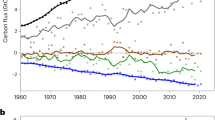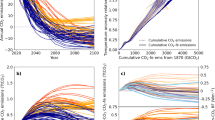Abstract
International efforts to limit global warming and ocean acidification aim to slow the growth of atmospheric CO2, guided primarily by national and industry estimates of production and consumption of fossil fuels. Atmospheric verification of emissions is vital but present global inversion methods are inadequate for this purpose. We demonstrate a clear response in atmospheric CO2 coinciding with a sharp 2010 increase in Asian emissions but show persisting slowing mean CO2 growth from 2002/03. Growth and inter-hemispheric concentration difference during the onset and recovery of the Global Financial Crisis support a previous speculation that the reported 2000–2008 emissions surge is an artefact, most simply explained by a cumulative underestimation (∼ 9 Pg C) of 1994–2007 emissions; in this case, post-2000 emissions would track mid-range of Intergovernmental Panel on Climate Change emission scenarios. An alternative explanation requires changes in the northern terrestrial land sink that offset anthropogenic emission changes. We suggest atmospheric methods to help resolve this ambiguity.
This is a preview of subscription content, access via your institution
Access options
Subscribe to this journal
Receive 12 print issues and online access
$209.00 per year
only $17.42 per issue
Buy this article
- Purchase on Springer Link
- Instant access to full article PDF
Prices may be subject to local taxes which are calculated during checkout




Similar content being viewed by others
Change history
20 June 2013
In the version of this Article originally published, in the 'Atmospheric versus emission trends' section, the second sentence of the third paragraph should have started "An underestimate of FF+LUC, and/or decreased atmospheric sinks..." This error has now been corrected in the HTML and PDF versions.
References
Trudinger, C. M., Enting, I. G., Etheridge, D. M., Francey, R. J. & Rayner, P. J. in A History of Atmospheric CO2 and Its Effect of Plants, Animals and Ecosystems (eds Ehleringer, J. R., Cerling, T. E. & Dearing, M. D.) 329–349 (Ecological Studies, Vol. 177, Springer, 2005).
Keeling, C. D. et al. in A History of Atmospheric CO2 and Its Effects on Plants, Animals, and Ecosystems (eds Ehleringer, J. R., Cerling, T. E. & Dearing, M. D.) 83–113 (Ecological Studies, Vol. 177, Springer, 2005).
Boden, T. A., Marland, G. & Andres, R. J. Global, Regional, and National Fossil-fuel CO2 Emissions (Carbon Dioxide Information Analysis Center, 2010) http://cdiac.ornl.gov/trends/emis/overview.html.
Houghton, R. A. in TRENDS: A Compendium of Data on Global Change (Carbon Dioxide Information Analysis Center, 2008); available at http://cdiac.esd.ornl.gov/trends/landuse/houghton/houghton.html.
Francey, R. J. et al. Differences between trends in atmospheric CO2 and reported trends in anthropogenic CO2 emissions. Tellus 62, 316–328 (2010).
Le Quéré, C., Raupach, M. R., Canadell, J. G. & Marland, G. Trends in the sources and sinks of carbon dioxide. Nature Geosci. 2, 831–837 (2009).
Peters, G. P. et al. Rapid growth in CO2 emissions after the 2008–2009 global financial crisis. Nature Clim. Change 2, 2–4 (2012).
Friedlingstein, P. et al. Update on CO2 emissions. Nature Geosci. 3, 811–812 (2010).
Andres, R. J. et al. Synthesis of carbon dioxide emissions from fossil-fuel combustion. Biogeosciences 9, 1845–1871 (2012).
Guan, D., Liu, Z., Geng, Y., Lindner, S. & Hubacek, K. The gigatonne gap in China’s carbon dioxide inventories. Nature Clim. Change 2, 672–675 (2012).
Marland, G. Emissions accounting: China’s uncertain CO2 emissions. Nature Clim. Change 2, 645–646 (2012).
Ballantyne, A. P., Alden, C. B., Miller, J. B., Tans, P. P. & White, J. W. C. Increase in observed net carbon dioxide uptake by land and oceans during the past 50 years. Nature 488, 70–72 (2012).
Pan, Y. et al. A large and persistent carbon sink in the world’s forests. Science 333, 988–993 (2011).
Sarmiento, J. L. et al. Trends and regional distributions of land and ocean carbon sinks. Biogeosciences 7, 2351–2367 (2010).
Le Quéré, C., Takahashi, T., Buitenhuis, E. T., Rödenbeck, C. & Sutherland, S. C. Impact of climate change and variability on the global oceanic sink of CO2 . Glob. Biogeochem. Cycles 24, GB4007 (2010).
Van der Werf, G. et al. Global fire emissions and the contribution of deforestation, savanna, forest, agricultural, and peat fires (1997–2009). Atmos. Chem. Phys. 10, 11707–12010 (2010).
Frölicher, T. L., Joos, F. & Raible, C. C. Sensitivity of atmospheric CO2 and climate to explosive volcanic eruptions. Biogeosciences 8, 2317–2339 (2011).
Rayner, P. J. et al. The interannual variability of the global carbon cycle (1992-2005) inferred by inversion of atmospheric CO2 and 13CO2 measurements. Glob. Biogeochem. Cycles 22, GB3508 (2008).
Francey, R. J. & Steele, L. P. Measuring atmospheric carbon dioxide—The calibration challenge. Accredit. Qual. Assur. 8, 200–204 (2003).
Francey, R. J. et al. in Baseline Atmospheric Program (Australia) 1993 (eds Francey, R. J., Dick, A. L. & Derek, N.) 8–29 (Bureau of Meteorology and CSIRO Division of Atmospheric Research, 1996).
Yevich, R. & Logan, J. A. An assessment of biofuel use and burning of agricultural waste in the developing world. Glob. Biogeochem. Cycles 17, 1095 (2003).
Knorr, W. Is the airborne fraction of anthropogenic CO2 emissions increasing? Geophys. Res. Lett. 36, L21710 (2009).
Rödenbeck, C., Houweling, S., Gloor, M. & Heimann, M. CO2 flux history 1982–2001 inferred from atmospheric data using a global inversion of atmospheric transport. Atmos. Chem. Phys. 3, 1919–1964 (2003).
http://www.esrl.noaa.gov/psd/data/gridded/data.ncep.reanalysis.html.
Dargaville, R. J., Law, R. M. & Pribac, F. Implications of interannual variability in atmospheric circulation on modeled CO2 concentrations and source estimates. Glob. Biogeochem. Cycles 14, 931–943 (2000).
Le Quéré, C. et al. Saturation of the Southern Ocean CO2 sink due to recent climate change. Science 316, 1735–1738 (2007).
Manning, M. et al. Misrepresentation of the IPCC CO2 emission scenarios. Nature Geosci. 3, 376–377 (2010).
Levin, I. et al. Observations and modelling of the global distribution and long-term trend of atmospheric 14CO2 . Tellus 62B, 26–46 (2010).
Steele, L. P. et al. in Baseline Atmospheric Program (Australia) 1999–2000 (eds Tindale, N. W., Derek, N. & Fraser, P. J.) 80–84 (Bureau of Meteorology and CSIRO Atmospheric Research, 2003).
Zahorowski, W. et al. Radon-222 in boundary layer and free tropospheric continental outflow events at three ACE-Asia sites. Tellus B 57, 124–140 (2005).
Stephens, B. B. et al. The vertical distribution of atmospheric CO2 defines the latitudinal partitioning of global carbon fluxes. Science 316, 1732–1735 (2007).
Jones, C. D. & Cox, P. M. Modeling the volcanic signal in the atmospheric CO2 record. Glob. Biogeochem. Cycles 15, 453–465 (2001).
Statistical Review of World Energy (BP, 2011); available via http://go.nature.com/jrUwIm.
European Commission. Emissions Database for Global Atmospheric Research (EDGAR). Europa—EDGAR Overview http://edgar.jrc.ec.europa.eu/overview.php?v540 (2009).
Thoning, K. et al. Atmospheric carbon dioxide at Mauna Loa observatory, 2, Analysis of the NOAA/GMCC data, 1974–1985. J. Geophys. Res. 94, 8549–8565 (1989).
Enting, I. G. et al. Propagating data uncertainty through smoothing spline fits. Tellus B 58, 305–309 (2006).
Conway, T. J., Lang, P. M. & Masarie, K. A. Atmospheric carbon dioxide dry air mole fractions from the NOAA ESRL carbon cycle cooperative global air sampling network, 1968–2010, Version: 2011-10-14 (2011); available at ftp://ftp.cmdl.noaa.gov/ccg/co2/flask/event/.
Acknowledgements
G. Pearman’s emphasis on global representativeness during establishment of Australian CO2 monitoring underpins this work. Data used in this report are routinely submitted to the World Data Centre for Greenhouse Gases and CDIAC international databases (but in formats that preclude the data selection and uncertainty propagation used in this paper). More comprehensive and recent data, including LoFlo data, are available to researchers by contacting paul.krummel@csiro.au. CSIRO GASLAB staff and the Australian Bureau of Meteorology/Cape Grim Baseline Air Pollution Station continue to provide excellence in the operation of developmental equipment and in collection and processing of samples and data. Collection of samples at other sites is carried out with assistance from NOAA (USA), Environment Canada, Australian Antarctic Division and Australian Bureau of Meteorology. R.J.F, M.v.d.S., P.B.K., R.L.L., L.P.S and C.E.A. have been partly financially supported by the Bureau of Meteorology through the Cape Grim programme. R.J.A. was sponsored by US Department of Energy, Office of Science, Biological and Environmental Research (BER) programmes performed at Oak Ridge National Laboratory (ORNL) under US Department of Energy contract DE-AC05-00OR22725. CSIRO co-authors have been partly financially supported by the ACCSP (Australian Climate Change Science Program) through the Department of Climate Change and Energy Efficiency. A.R.S. is partially supported by an OCE (Office of Chief Executive) post-doctoral award. CCAM model simulations were undertaken on the NCI National Facility in Canberra, Australia, which is supported by the Australian Commonwealth Government. Valuable comments have been received from Y-P. Wang, P. Canadell, P. Rayner and A. Lenton.
Author information
Authors and Affiliations
Contributions
R.J.F, C.M.T. and R.M.L took lead roles in writing this paper. M.v.d.S., R.L.L, L.P.S and C.E.A. contributed to the design and quality control of measurements and P.B.K. developed and provided data processing. R.J.A. provided anthropogenic emissions data and advice. R.M.L. and C.R. designed, and with A.R.S., carried out inversion modelling tests. All authors advised on the manuscript.
Corresponding authors
Ethics declarations
Competing interests
The authors declare no competing financial interests.
Supplementary information
Supplementary Information
Supplementary Information (PDF 2407 kb)
Rights and permissions
About this article
Cite this article
Francey, R., Trudinger, C., van der Schoot, M. et al. Atmospheric verification of anthropogenic CO2 emission trends. Nature Clim Change 3, 520–524 (2013). https://doi.org/10.1038/nclimate1817
Received:
Accepted:
Published:
Issue Date:
DOI: https://doi.org/10.1038/nclimate1817
This article is cited by
-
Surprising stability of recent global carbon cycling enables improved fossil fuel emission verification
Nature Climate Change (2023)
-
Different types of industrial agglomeration and green total factor productivity in China: do institutional and policy characteristics of cities make a difference?
Environmental Sciences Europe (2022)
-
Japanese carbon emissions patterns shifted following the 2008 financial crisis and the 2011 Tohoku earthquake
Communications Earth & Environment (2021)
-
Implications of overestimated anthropogenic CO2 emissions on East Asian and global land CO2 flux inversion
Geoscience Letters (2017)
-
Accelerating net terrestrial carbon uptake during the warming hiatus due to reduced respiration
Nature Climate Change (2017)



